Small overlap front: driver-side
Rating applies to 2013-16 models
Tested vehicle: 2013 Dodge Dart SE 4-door
The Dodge Dart was introduced in the 2013 model year. Two tests of the Dart were conducted because electrical power to the onboard (car interior) cameras was interrupted during the first test. In the second Dart test, the driver door opened when the hinges tore away from the door frame. In the first test, the hinges were severely damaged and the lower one tore away, but the door stayed shut. In each test, the Dart’s safety belt and front and side curtain airbags appeared to adequately protect the dummy’s head and upper body, and measures from the dummy showed little risk of head and chest injuries.
As a result, the Institute averaged results of both tests and downgraded the Dart’s restraints and kinematics rating to marginal because doors shouldn’t open in a crash. Injury and structural ratings are based on both tests.
| Evaluation criteria | Rating |
|---|---|
| Structure and safety cage | |
| Driver injury measures | |
| Head/neck | |
| Chest | |
| Hip/thigh | |
| Lower leg/foot | |
| Driver restraints and dummy kinematics The driver door opened in the second test, which shouldn't happen because the driver could be partly or completely ejected from the vehicle. Still, in the second test, the dummy’s head loaded the frontal airbag, which stayed in front of the dummy until rebound. (Camera views from outside the car suggest that dummy movement was very similar in the first test.) In both tests, the side curtain airbag deployed but does not have sufficient forward coverage to protect the head from contact with forward side structure and outside objects. The side torso airbag also deployed in both tests. | |

Action shot taken during the second of two small overlap frontal crash tests.

Aside from the intruded door frame when the door hinges were sheared off in the second test (shown), the dummy's position in relation to the steering wheel and instrument panel after the crash test indicates that the driver's survival space was maintained reasonably well.

The frontal and side curtain airbags worked reasonably well together to protect the head from injury in the crash test (second test shown). Still, the curtain airbag should extend farther forward toward the A-pillar to protect the head from contact with forward side structure and outside objects if crash circumstances were to differ slightly.

Despite extensive intrusion and partial tearing of the door hinge pillar in the second test, risk of injury was moderate and limited to the left lower leg. The hinge pillar intruded far less in the first test, and risk of injuries to the legs and feet was low. Averaged together, injury risk remained low.
Moderate overlap front: original test
Rating applies to 2013-16 models
Tested vehicle: 2013 Dodge Dart Limited 4-door
The Dodge Dart was introduced in the 2013 model year.
| Evaluation criteria | Rating |
|---|---|
| Overall evaluation | |
| Structure and safety cage | |
| Driver injury measures | |
| Head/neck | |
| Chest | |
| Leg/foot, left | |
| Leg/foot, right | |
| Driver restraints and dummy kinematics | |
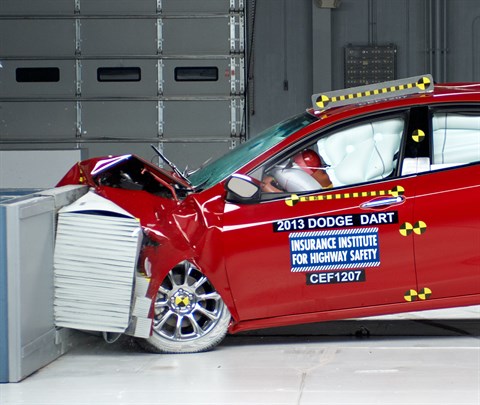
Action shot taken during the frontal offset crash test.
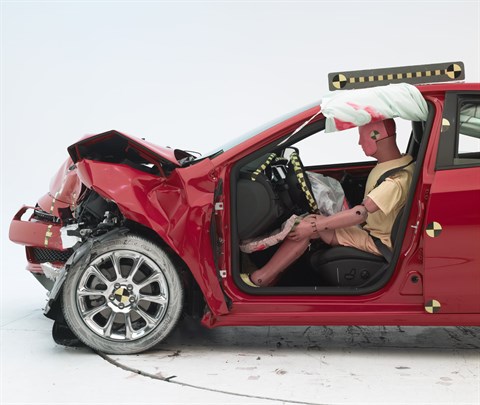
The dummy's position in relation to the steering wheel and instrument panel after the crash test indicates that the driver's survival space was maintained very well.

Smeared greasepaint shows where the driver dummy's head was protected from hitting hard structures during rebound by the side curtain airbag.

Intrusion into the driver's space was minimal, and all leg and foot injury measures were low. The deployed knee airbag is visible just ahead of the dummy's lower legs.
Side: original test
Rating applies to 2013-16 models
Tested vehicle: 2013 Dodge Dart Limited 4-door with standard front and rear head curtain airbags, standard front seat-mounted torso airbags, and standard rear seat-mounted pelvis airbags
The Dodge Dart was introduced in the 2013 model year.
| Evaluation criteria | Rating |
|---|---|
| Overall evaluation | |
| Structure and safety cage | |
| Driver injury measures | |
| Head/neck | |
| Torso | |
| Pelvis/leg | |
| Driver head protection | |
| Rear passenger injury measures | |
| Head/neck | |
| Torso | |
| Pelvis/leg | |
| Rear passenger head protection | |
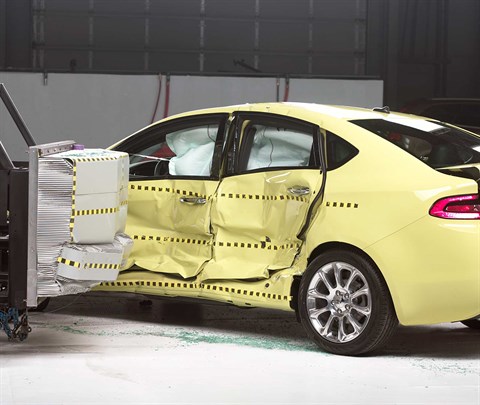
View of the vehicle and barrier just after the crash test.
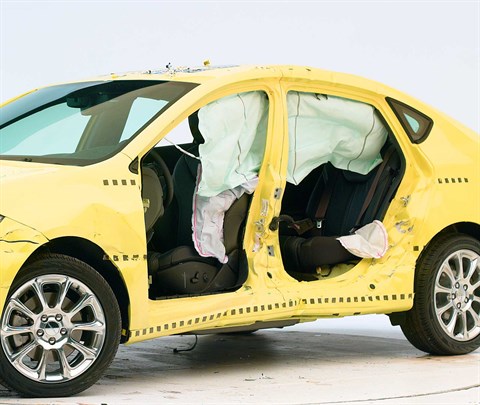
View of the vehicle after the crash with doors removed, showing the side airbags and damage to the occupant compartment.
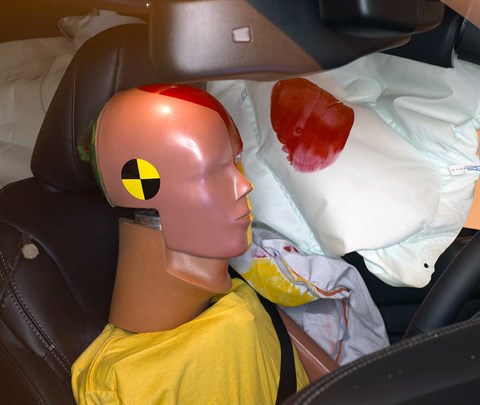
Smeared red and yellow greasepaint shows where the driver dummy's head was protected from being hit by hard structures by the side airbags.

Smeared greasepaint shows where the rear passenger dummy’s head was protected by the side airbag.
Roof strength
Rating applies to 2013-16 models
Tested vehicle: 2013 Dodge Dart Limited 4-door
| Overall evaluation | |
|---|---|
| Curb weight | 3,330 lbs |
| Peak force | 16,554 lbs |
| Strength-to-weight ratio | 4.97 |
Head restraints & seats
Seat type: Power leather seats
| Overall evaluation | |
|---|---|
| Dynamic rating | |
| Seat/head restraint geometry |
About the head restraint & seat test
Currently, IIHS tests apply only to front seats.
